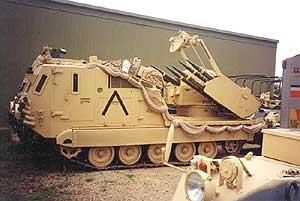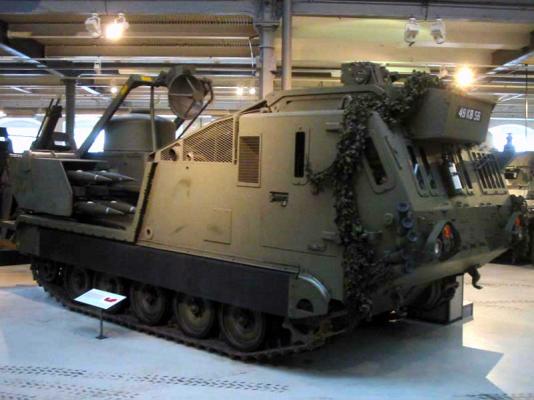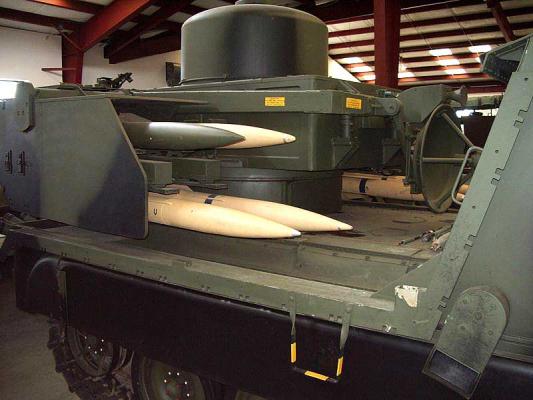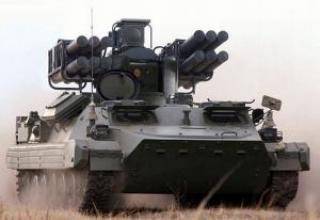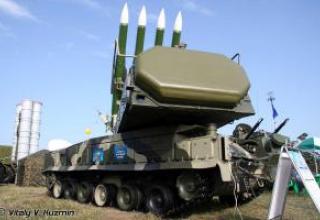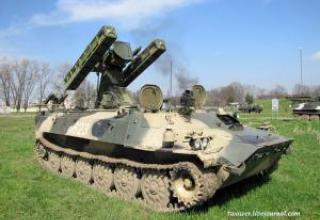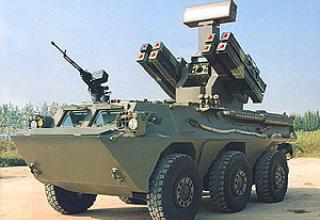Self-propelled air defense missile system "Tracked Rapier" is designed to directly cover the combat orders of land forces in combat and on the march and provides air targets at ranges of 0.5-7 km and altitudes from 30 to 3600m. The creation of this complex began in 1974 by the "Guided Weapons Division" of the British Aerospace Dynamics Corporation on the basis of towed Rapier SAM system, which had been in service with the British Army since 1972. As a chassis was chosen a tracked transporter M548 - a prototype of M113 family, which is in service with more than 40 countries. Series production began in 1978, and the first complexes were put into service in 1983.
The complex was repeatedly upgraded in order to ensure its combat use at any time and in any weather. The variant of the "Tracked Rapier" complex, equipped with thermal imaging equipment for target detection and tracking, received the designation SP Mk.lB, as opposed to the original SP Mk.ІA. Supplies of SP Mk.lB SAM systems to the British Armed Forces began in 1993.
The self-propelled system is compatible with all types of Rapier SAMs, including the new Mk.2 missile of the Rapier-2000 system (FSC).
At present, the production of the complex is completed. For 1997. 72 complexes were in service with the UK. It is planned to decommission and replace the Starstreak self-propelled system by Thales Air Defence Ltd.
Composition:
The complex "Tracked Rapier" includes :
- TRLV (Tracked Rapier Launch Vehicle) combat vehicle;
- Rapier" missiles of Mk.l, Mk.lE, Mk.2 variants are identical to the SAMs used in the towed Rapier complex;
- TRSV (Tracked Rapier Support Venicle) transport and charging vehicle on M548 chassis with a crew of 2 persons, having on board an ammunition of 20 missiles in transport containers;
- FAST (Forward Area Support Team) technical support vehicle to provide emergency technical assistance, diagnostics and repair of the TRLV combat vehicle. The crew consists of two people, with communication equipment, a crane, test equipment and a MAL.
Combat vehicle "Rapier-TRLV" is designated RCM-748. On the tracked chassis is placed the launcher, which has 4 missiles on each side. The antenna of radio command system of guidance of J-band is mounted on the rising mechanism of the bracket type, in the unfolded state of which allowed the launch of missiles. On the rotary platform is placed impulse Doppler radar detection of air targets with a range of 11.5 km, a computing device, identification equipment system "in-situ". The rotating platform rotates through 360°. The crew of three is located in an armored cockpit, protecting the crew from shell splinters and bullet hits. The driver is on the left side, the commander is in the centre and the operator is on the right. Both the driver and the commander can use night vision and firefighting equipment if necessary.
In case of autonomous operation of the complex or in the absence of radar information, the combat vehicle commander visually detects the target and captures it for auto tracking, using the standard GEC optical system - Marconi Helmet Pointer System. The commander's workplace (see photo) is equipped with TCU (Tactical Control Unit), equipment for functional control and radio communications. All equipment is vibration-resistant. The TCU provides tactical control and automatic selection of the firing sector. In the fire control system of the complex enter data on areas of priority action against air targets of the enemy, ie, the areas that are protected by this complex. There are 32 sectors by azimuth, the size of each sector is 11°25'. The sectors are assigned a priority system and the tracking system is automatically activated to the first target detected by the radar, providing priority firing of the target flying from the priority direction. The system design allows the operator to interrupt the target acquisition process and manually switch the system to another target.
Tracked Rapier" complex in SP Mk.lB version, equipped with TOTE (Tracked Optical Thermally Enhanced) detection system, can be used at any time of the day and night. The upgraded TOTE detection system includes a thermal imaging camera with a range of up to 10 km, additional electronic equipment and a cooling system. The operator accompanies the target visually using a telescopic sight, or with the help of a thermal imaging camera in bad weather and at night. The tracking system is mounted on an anti-vibration platform on the right side of the cab. When deployed, it rises to the working position and is folded and removed when finished. When folded, it is protected by an armoured flap. Optical and tracking systems are used to capture the missile and bring it to the line of sight, then assess its deviation from the line of sight and in order to correct the flight to the meeting point are produced and transmitted to the control team aboard the missile. Combining the thermal imaging channel with the optical channel for target tracking allows to carry out combat operations in the passive mode (without going on the air of radar) until the launch of the missile in night conditions. The equipment of the TOTE thermal imaging channel is mounted together with an optical system. The essence of combat operations remains the same.
The Mk.l rocket is identical to the one used in the towed "Rapier" complex. It requires no maintenance, no storage checks. The warranty period is 10 years. The missile has high maneuverability and can manoeuver with high overloads at maximum range to engage manoeuvering targets. The manual recharging time of the eight missiles is about 5 minutes. The average probability of hitting a target with one missile is 0.7. When performing the march, the complex is ready to start firing 15 seconds after the stop. The reaction time for the first missile is 5 s, for the second - 2 s. Leaving the firing position is possible 20 seconds after the firing has been completed.
The observation radar rotates in a circular pattern. When a target is detected, it automatically recognizes its nationality by means of an "alien" identification system. If the target is a stranger, the operator is informed by an audible signal in his headphones. At the same time, the rotating platform with the optical system automatically turns towards the target together with the missiles. If necessary, the operator can make a manual turn to point the target more accurately. Once the operator has captured the target to be escorted, he begins to escort the target using the joystick. The information from the optical tracking system and the observation radar is fed to a computing device, where the possibility of the target entering the area of engagement is calculated. When the target enters the area of engagement, a warning light comes on in the operator's field of view and the operator immediately presses the missile's start button. The calculator determines the intended meeting point. The missile is automatically captured and guided to the intended rendezvous point by the optical system. During the flight of the missile to the rendezvous point, the operator must accompany the target.
To ensure all-weather combat, the Rapier self-propelled SAM system can be provided with one more tracked chassis with a target tracking radar and a Blindfire missile. During the combat operation the "Blindfire" radar accompanies both the missile and the target with a very narrow beam.
Self-propelled complex "Rapier" is all-terrain, amphibious (in preliminary preparation), one chassis is delivered to any place in the world with the help of transport aircraft C-130. The landing gear has a low profile and accordingly low visibility, low infrared signature and the ability to passively view the space. The engine is 6V-53 six-cylinder liquid-cooled diesel engine with an output of 210 hp at 2800 rpm. Maximum speed on land - 48 km/h, on water - 5.6 km/h. Turning radius - 4.3m, power reserve without refueling - 300km.
Characteristics:
| Range of fire, km | |
| - minimum | 0.025 |
| - maximum | 7 |
| Target kill altitude, km | |
| - minimum | 0,15 |
| - maximum | 3.35 |
| Weight of the launcher, kg | 14010 |
| Crew, man. | 3 |
| Ground pressure, kg/cm2 | 0,63 |
| Length, m | 6.4 |
| Width, m | 2.8 |
| Height with deployed optical system, m | 2.78 |
| Height for air transport, m | 2.50 |
| Clearance, m | 0.41 |
| Rapier rocket Mk.1 | |
| Starter weight, kg | 42.6 |
| Length, mm | 2240 |
| Maximum housing diameter, mm | 130 |
| Swing of stabilizers, mm | 380 |
| Maximum flight speed, m/s | 650 |
Testing:
As part of the UK's 12th Air Defence Regiment, Rapier SAMs participated in combat operations during the Falkland conflict in 1982. 12 launchers have been deployed since the first day of the English landing on the Falkland Islands. Sources from the English government (White Paper: The Falkland Campaign. Lessons) claim that 14 Argentine planes were destroyed by Rapier complexes. However, according to other information, the "Rapier" complex shot down only one AI Dogger A and participated in the destruction of the A-4C Skyhawk. The Blindfire radar did not participate in these hostilities.
The Rapier complex participated on the Iranian side in the war between Iran and Iraq in the 1970s, and is believed to have destroyed an Iraqi Tu-22 type bomber.
The "Rapier" SAM system was also deployed for the English multinational air defense contingent during Operation Desert Storm in 1991.
Sources:
- Василин Н.Я., Гуринович А.Л. "Зенитные ракетные комплексы" .-Мн.: ООО "Попурри", 2002- 464с.
- Пересада С.А. "Зенитные ракетные комплексы" Военное издательство Министерства обороны СССР, Москва, 1973 г.
- "Tracked Rapier"
- " RAPIER FlaRak-System (UK)
